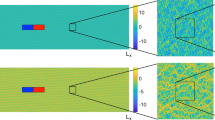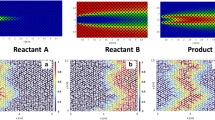Abstract
We characterize the role of preferential pathways in controlling the dynamics of bimolecular reactive transport in a representative model of a heterogeneous porous medium. We examine a suite of numerical simulations that quantifies the irreversible bimolecular reaction \(A+B\rightarrow C\), in a two-dimensional heterogeneous domain (with log-conductivity, Y), wherein solute A is injected along an inlet boundary to displace the resident solute B under uniform (in the mean) flow conditions. We explore the feedback between the reactive process and (a) the degree of system heterogeneity, as quantified by the unconditional variance of Y, \(1 \le \sigma _Y^2\le 7\), representing moderately to strongly heterogeneous media, and (b) the relative strengths of advective and diffusive mechanisms, as quantified by a grid Péclet number, \(\textit{Pe}_ {\Delta }\). Our analysis is based on the identification of particle preferential pathways, focusing on particle residence time within cells employed to discretize the flow domain. These preferential pathways are formed mainly by high conductivity cells and generally contain an important component of (sometimes isolated and a relatively small number of) lower conductivity values. A key finding of our analysis is that while the former dominate the behavior, the latter are shown to provide a non-negligible contribution to the global number of reactions taking place in the domain for strongly heterogeneous media, i.e., for the largest investigated values of \(\sigma _Y^2 \). Reactions are detected across the complete simulation time window (of about 5.5 pore volumes) for the strongly advective case. When diffusion plays an important role, the reactive process essentially stops after the injection of a limited amount (\(\sim \)2.5) of pore volumes.










Similar content being viewed by others
References
Ambegaokar, V., Halperin, B.I., Langer, J.S.: Hopping conductivity in disordered systems. Phys. Rev. B 4, 2612–2620 (1971)
Auriault, J.-L., Adler, P.M.: Taylor dispersion in porous media: analysis by multiple scale expansions. Adv. Water Resour. 18, 217–226 (1995)
Battiato, I., Tartakovsky, D.M.: Applicability regimes for macroscopic models of reactive transport in porous media. J. Contam. Hydrol. 120–1, 18–26 (2009)
Bear, J., Cheng, A.: Modeling Groundwater Flow and Contaminant Transport. Springer Science & Business Media, Berlin (2010)
Berkowitz, B., Scher, H., Silliman, S.E.: Anomalous transport in laboratory-scale, heterogeneous porous media. Water Resour. Res. 36, 149–158 (2000)
Berkowitz, B., Cortis, A., Dentz, M., Scher, H.: Modeling non-Fickian transport in geological formations as a continuous time random walk. Rev. Geophys. 44, RG2003 (2006)
Bianchi, M., Zheng, C., Wilson, C., Tick, G.R., Liu, G., Gorelick, S.M.: Spatial connectivity in a highly heterogeneous aquifer: from cores to preferential flow paths. Water Resour. Res. 47, W05524 (2011)
Bijeljic, B., Blunt, M.J.: Pore scale modeling and continuous time random walk analysis of dispersion in porous media. Water Resour. Res. 42, W01202 (2006)
Bijeljic, B., Mostaghimi, P., Blunt, M.J.: Signature of non-Fickian solute transport in complex heterogeneous porous media. Phys. Rev. Lett. 107, 204502 (2011)
Bolster, D., Benson, D.A., Le Borgne, T., Dentz, M.: Anomalous mixing and reaction induced by super-diffusive non-local transport. Phys. Rev. E 82, 021119 (2010)
Chiogna, G., Bellin, A.: Analytical solution for reactive solute transport considering incomplete mixing within a reference elementary volume. Water Resour. Res. 49(5), 2589–2600 (2013)
Ciriello, V., Edery, Y., Guadagnini, A., Berkowitz, B.: Multimodel framework for characterization of transport in porous media. Water Resour. Res. 51, 3384–3402 (2015)
De Anna, P., Jimenez-Martinez, J., Tabuteau, H., Turuban, R., Le Borgne, T., Derrien, M., et al.: Mixing and reaction kinetics in porous media: an experimental pore-scale quantification. Environ. Sci. Technol. 48(1), 508–516 (2013)
De Anna, P., Dentz, M., Tartakovsky, A., Le Borgne, T.: The filamentary structure of mixing fronts and its control on reaction kinetics in porous media flows. Geophys. Res. Lett. 41(13), 4586–4593 (2014)
Edery, Y., Scher, H., Berkowitz, B.: Modeling bimolecular reactions and transport in porous media. Geophys. Res. Lett. 36(2), L02407 (2009)
Edery, Y., Scher, H., Berkowitz, B.: Particle tracking model of bimolecular reactive transport in porous media. Water Resour. Res. 46(7), W07524 (2010)
Edery, Y., Guadagnini, A., Scher, H., Berkowitz, B.: Reactive transport in disordered media: role of fluctuations in interpretation of laboratory experiments. Adv. Water. Resour. 51, 86–103 (2013)
Edery, Y., Guadagnini, A., Scher, H., Berkowitz, B.: Origins of anomalous transport in heterogeneous porous media: structural and dynamic controls. Water Resour. Res. 50, 1490–1505 (2014)
Esfandiar, B., Porta, G., Perotto, S., Guadagnini, A.: Impact of space-time mesh adaptation on solute transport modeling in porous media. Water Resour. Res. 51, 1315–1332 (2015)
Haggerty, R., Harvey, C.F., von Schwerin, C.F., Meigs, L.C.: What controls the apparent timescales in aquifers and soils? A comparison of experimental results. Water Resour. Res. 40, W01510 (2004)
Hansen, S.K., Scher, H., Berkowitz, B.: First-principles derivation of reactive transport modeling parameters for particle tracking and PDE approaches. Adv Water Resour. 69, 146–158 (2014)
Kang, P.K., de Anna, P., Nuñes, J.P., Bijeljic, B., Blunt, M.J., Juanes, R.: Pore-scale intermittent velocity structure underpinning anomalous transport through 3-D porous media. Geophys. Res. Lett. 41, 6184–6190 (2014)
Katz, G.E., Berkowitz, B., Guadagnini, A., Saaltink, M.W.: Experimental and modeling investigation of multicomponent reactive transport in porous media. J. Contam. Hydrol. 120–1, 27–44 (2011)
Kirkpatrick, S.: Classical transport in disordered media: scaling and effective medium theories. Phys. Rev. Lett. 27, 1722–1725 (1971)
Lawrence, A.E., Rubin, Y.: Block-effective macrodispersion for numerical simulations of sorbing solute transport in heterogeneous porous formations. Adv. Water Resour. 30(5), 1272–1285 (2007)
Luo, J., Cirpka, O.A.: How well do mean breakthrough curves predict mixing-controlled reactive transport? Water Resour. Res. 47, W02520 (2011)
Porta, G.M., Riva, M., Guadagnini, A.: Upscaling solute transport in porous media in the presence of an irreversible bimolecular reaction. Adv. Water Resour. 35, 151–162 (2012)
Porta, G.M., Chaynikov, S., Thovert, J.-F., Riva, M., Guadagnini, A., Adler, P.M.: Numerical investigation of pore and continuum-scale formulations of bimolecular reactive transport in porous media. Adv Water Resour. 62, 243–53 (2013)
Porta, G.M., Bijeljic, B., Blunt, M.J., Guadagnini, A.: Continuum-scale characterization of solute transport based on pore-scale velocity distributions. Geophys. Res. Lett. 42, 7537–7545 (2015)
Porta, G.M., Ceriotti, G., Thovert, J.-F.: Comparative assessment of continuum-scale models of bimolecular reactive transport in porous media under pre-asymptotic conditions. J. Contam. Hydrol. 185–6, 1–13 (2016)
Riva, M., Guadagnini, A., Fernandez-Garcia, D., Sanchez-Vila, X., Ptak, T.: Relative importance of geostatistical and transport models in describing heavily tailed breakthrough curves at the Lauswiesen site. J. Contam. Hydrol. 101, 1–13 (2008)
Rolle, M., Kitanidis, P.K.: Effects of compound-specific dilution on transient transport and solute breakthrough: a pore-scale analysis. Adv. Water Resour. 71, 186–199 (2014)
Rubin, J.: Transport of reacting solutes in porous media: relation between mathematical nature of problem formulation and chemical nature of reactions. Water Resour. Res. 19(5), 1231–1252 (1983)
Rubin, Y., Bellin, A., Lawrence, A.E.: On the use of block-effective macrodispersion for numerical simulations of transport in heterogeneous formations. Water Resour. Res. 39(9), 1242 (2003)
Salles, J., Thovert, J.-F., Delannay, R., Prevors, L., Auriault, J.-L., Adler, P.M.: Taylor dispersion in porous media. Determination of the dispersion tensor. Phys. Fluids A 5(10), 2348–2376 (1993)
Severino, A., Tartakovsky, D.M., Srinivasan, G., Viswanathan, H.: Lagrangian models of reactive transport in heterogeneous porous media with uncertain properties. Proc. R. Soc. A 468, 1154–1174 (2012)
Tartakovsky, A.M., Redden, G., Lichtner, P.C., Scheibe, T.D., Meakin, P.: Mixing-induced precipitation: experimental study and multi-scale numerical analysis. Water Resour. Res. 44, W06S04 (2008)
Tyuchova, A.R., Kinzelbach, W., Willmann, M.: Delineation of connectivity structures in 2-D heterogeneous hydraulic conductivity fields. Water Resour. Res. 51, 5846–5854 (2015)
Zhang, Y., Benson, D.A., Reeves, D.M.: Time and space nonlocalities underlying fractional-derivative models: distinction and review of field applications. Adv. Water Resour. 32, 561–581 (2009)
Acknowledgments
B. B. gratefully acknowledges support by the Minerva Foundation, with funding from the Federal German Ministry for Education and Research. B. B. holds the Sam Zuckerberg Professorial Chair in Hydrology. A. G. acknowledges funding from MIUR (Italian Ministry of Education, Universities and Research—PRIN2010-11; Project: “Innovative methods for water resources under hydro-climatic uncertainty scenarios”). We thank Marco Panzeri for his help with the numerical flow simulations.
Author information
Authors and Affiliations
Corresponding author
Appendix: Dependence on Number of Realizations
Appendix: Dependence on Number of Realizations
We illustrate here selected results of a convergence study that examined the dependence of our results on the number of realizations, \(n_Y \). All results presented here are for the case with \(\sigma _Y^2 =7\). Figure 11 shows how the total number of reactions, \(N_R \), displayed in Fig. 2, depends on \(n_Y \) for various pore volumes eluted from the system. Here, \(N_R \) is normalized with respect to the results shown in Fig. 2, obtained for \(n_Y=20\). Note that oscillations of limited amplitude are observed for \(n_Y>\) 15 at all simulation times. Figure 12a depicts the frequency distribution \(F_{\textit{YR}} \) shown in Fig. 4a for \(n_Y =5\), 10, 15, 20. These results are complemented by Fig. 12b which shows the convergence of the quantities \(M_{\textit{YR}}\) (with \(M =\mu \), \(\sigma ^{2}\), or \(\gamma )\) that are considered in Fig. 4b. All three statistical moments display only small variations with respect to the result obtained with 20 realizations for \(n_Y>15\). Results in Figs. 11 and 12 suggest that the number of realizations employed in this study is sufficient to characterize the reactive process in the entire domain and the distribution of reactions conditional to conductivity values.
Total number of reactions, \(N_R \), versus \(n_Y \) for various pore volumes eluted from the system and for \(\sigma _Y^2 =7\). Here, \(N_R \) is normalized with respect to \(N_R \)(20), i.e., to the results shown in Fig. 2 and obtained for \(n_Y=20\). Thin colored curves correspond to \(N_R \) evaluated at a set of selected pore volumes (\({\textit{PV}}<5.5\)). The black bold curve corresponds to \(N_R \) at the final simulation time (\({\textit{PV}} = 5.5\))
Impact of the number of realizations \(n_Y \) on the results shown in Fig. 4; a same results as in Fig. 4a for \(\sigma _Y^2 =7\) computed on the basis of \(n_Y = 5\) (green), 10 (red), 15 (blue) and 20 (bold black) realizations; b related statistical moments of the distributions (results are normalized with respect to the results shown in Fig. 4b–d and obtained for \(n_Y=20\) and \(\sigma _Y^2 =7\)
Rights and permissions
About this article
Cite this article
Edery, Y., Porta, G.M., Guadagnini, A. et al. Characterization of Bimolecular Reactive Transport in Heterogeneous Porous Media. Transp Porous Med 115, 291–310 (2016). https://doi.org/10.1007/s11242-016-0684-0
Received:
Accepted:
Published:
Issue Date:
DOI: https://doi.org/10.1007/s11242-016-0684-0






